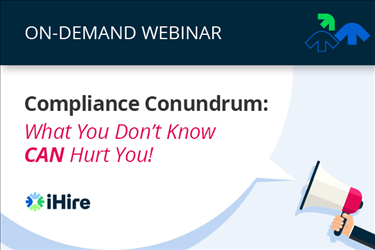- Employer Resources
- |
- Last Updated: June 22, 2023

Blind Hiring 101: Addressing Bias in Your Recruiting Process
Diverse and inclusive hiring practices have become a critical commitment for today’s business leaders. Building a workforce representative and reflective of society’s overall diversity seems easy enough from a conscious standpoint. However, there is more to the issue than meets the eye due to unconscious bias.
According to Psychology Today, “Unconscious bias, also known as implicit bias, refers to unconscious forms of discrimination and stereotyping based on race, gender, sexuality, ethnicity, and age.” Even with a highly proactive diversity program, unconscious bias can undermine your efforts, which is why businesses committed to hiring a diverse team are investing in blind hiring practices to ensure a process void of biases.
What Is Blind Hiring?
Blind hiring is an increasingly popular practice for today’s recruiting professionals. It entails removing any personally identifiable information from each candidate’s resume. The information removed includes name, address, age, education, and dates of employment. The removal of this information allows the recruiter to solely focus on applicants’ skills and experience, rather than details such as age, race, and gender, which can all trigger unconscious bias.
With blind recruiting, your hiring team can feel confident knowing that no unconscious biases crept into the equation, allowing them to hire the right person with the right qualifications for a position and further their fair hiring mission.

How to Use Blind Hiring Practices to Eliminate Unconscious Bias
When you are ready to implement blind hiring practices in your organization, you might need some pointers to get started. Here are some ideas to help you adopt and apply this technique successfully.
1. Invest in an HR Software Tool
With this relatively new fair hiring technique for eliminating unconscious bias, you might need some help applying it correctly to ensure accurate blinded information. Attempting to do it manually on your own can lead to vulnerabilities in the process that allows biases to sneak into recruiting. Software programs that feature special tools to remove information will work much better, saving time and money.
iHire’s Bias Breaker™ feature is one such tool. Bias Breaker is an optional tool for employers with an active iHire account that automatically hides candidate names, contact information, and photos on their resume and application until you’re ready to contact them. Names are displayed as initials, and other personal information is replaced with a generic descriptor like “[Email]” or “[Address].” You also have the option to hide school/organization names, links, and dates if you choose. This allows you to focus on candidates' skills and qualifications using fair hiring practices, expand your talent pool, and diversify your workplace.
2. Anonymize and Standardize Your Fair Hiring Processes
While a feature like Bias Breaker is recommended for a truly anti-bias process, not everyone has the budget for a new software tool. In that case, there are some processes you can use to anonymize your candidates:
- Pull applicants’ information into a spreadsheet and filter out specific data. Instruct hiring managers to look only at the unfiltered information.
- Customize a standardized application, focusing on filling out only information related to relevant skills or work experience.
- Tap an associate who is not involved in the recruiting process to remove personal information from resumes before they are shared with the hiring manager for screening.
3. Avoid Social Media Prescreening
A quick way to undo all the work you’ve put into your blind hiring techniques is to see a candidate’s name and photograph on LinkedIn or another social media site. At one time, reviewing candidates’ social media accounts was a crucial way to unearth valuable insights into each candidate. Now, it’s more important to avoid stumbling onto those accounts to avoid running into anything that could create bias. If needed, save your social media screening efforts for the end of the hiring process.
4. Set Up Anonymous Interviews
The process of setting up an anonymous interview comes with its share of challenges. Even when conducting interviews via voice calls only, you might zoom in on an accent, pitch, or tone that can clue you in on traits such as age, gender, or race – resulting in unconscious biases.
You can also conduct a pre-phone interview Q&A via email, asking specific questions and awaiting written responses.
Create Your Account Today
What Does Your Hiring Team Need to Know About Blind Hiring?
One of the best ways to start blind recruiting is to create neutral, unbiased job descriptions that appeal to a broad range of diverse candidates. Focus solely on the qualifications and experience needed for the job.
Avoid language that suggests you want a specific type of candidate, such as something as seemingly innocent as “a world traveler” or someone “down to earth.” Such language might instantly cause a candidate to feel excluded from the pool.
Finally, work to make blind hiring and anti-bias a part of your hiring culture, if not your company culture. This will help everyone develop these skills that make it easier to work together toward shared goals.
Are There Pitfalls to Blind Hiring Practices?
Blind hiring is not a perfect process. Pitfalls and disadvantages of this hiring method include its expansion of the hiring window and the inability to gain insights into each candidate’s personality to see if they fit with the corporate culture.
In Summary
Blind hiring can help your team eliminate unconscious biases from the recruiting process, which can lead to a more diverse workforce. Most importantly, you will find people uniquely qualified for your open position based on their experience and skills.
For more diversity and inclusion resources, check out our Employer Resource Center.




